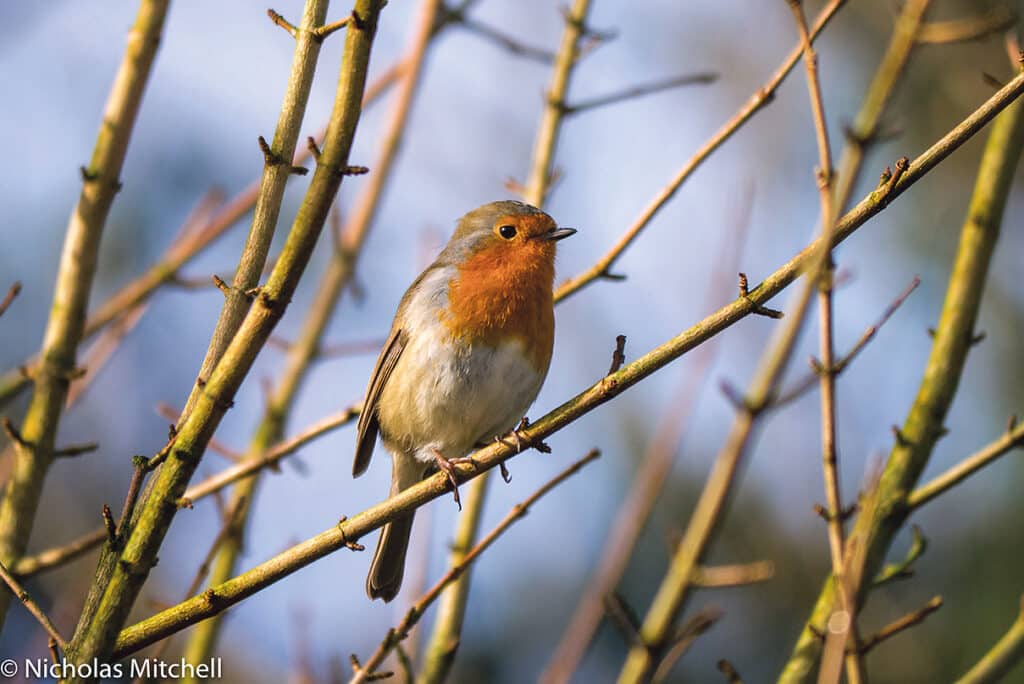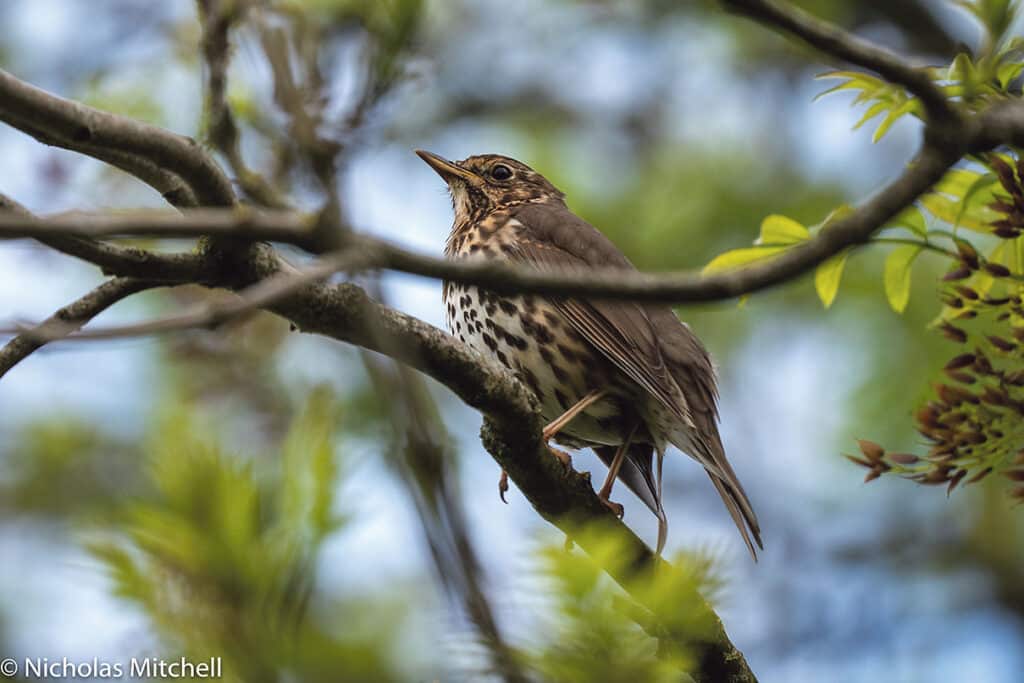Nicholas Mitchell explains why it’s not too early in the year to talk about bird song, normally associated with the dawn chorus.

Robin. Pics: Nicholas Mitchell 
Song Thrush (male – Turdus philomenos)
Our resident birds have already started to sing. We humans mark the beginning of spring with the celebration of St Brigid on the first day of February. St Brigid’s Day ‘Lá Fhéile Bríde’ is our festival of fertility, signalling an end to the winter darkness and heralding a new season of hope and growth. Birds have no need of such festivals; they recognise the arrival of spring with the lengthening daylight and an innate urge to reproduce. With this comes a change in their behaviour. Our resident bird population need to find breeding territories and mates. Our summer visiting birds feel the same, but first they have an ingrained need to leave their wintering grounds and fly north to their breeding area. Whether resident or summer visitor, birds use song to help achieve their need to mate. Generally it is the males that sing, and they do so to proclaim a territory and to attract a mate.
Once a suitable territory has been found, one that will provide the birds with food and water, protection, and good nesting sites, then the birds will sing to advertise to other birds of the same species that this plot is now claimed. Birds of other species are unlikely to be in competition for the same type of food or for similar nesting sites, so the song is not directed at them and different species will coexist in the same area. Birds also use their song to ‘show off’ to, and hopefully attract, the opposite sex. As already stated, singing is generally performed by the male of the species. One notable exception to this is the Robin.
We humans have a larynx, an impressive instrument in its own right, but birds have a syrinx. This is positioned closer to the lungs and has two bronchial tubes instead of one, which allows most birds to sing with two pitches at the same time and independently of each other. As a result, birds can have a range and variety of notes that would have an opera singer weeping with jealousy. If you have ever heard a Skylark sing whilst hovering high in the sky, sometimes for ten minutes or more, you will also realise that birds can both inhale and exhale while singing.
Who is singing that song?
The dawn chorus is when bird song reaches a crescendo, but if you have ever heard a bird singing and wanted to identify that bird by its song, then now is the time to start learning. The birds are already starting to sing now and, most crucially, they can be seen. Trees only start coming into leaf in March with the Elder and finish in May with the Ash. This leaves a lengthy period when birds are singing and some or all of the branches are bare; perfect for finding and identifying the bird that is singing. Going out to find and identify by sight the bird that is singing is by far the best way to learn, but here are a few pointers to some of our common resident birds:
Great Tit: Sings from January to June, sometimes later, in scrub, woodland, parks and gardens, and not so much in the open. It sounds like “teacher …..teacher ….teacher”.
Blue Tit: Can sing all year but mainly February to August, in scrub, woodland, parks and gardens, found on branches picking for insects. Its song is a high pitch tremolo ending in a lower pitched trill, like he’s telling a joke and then laughing.
Long-tailed Tit: Vocal all year round in woodland, parks and gardens, always moving in restless foraging parties. Listen for a sort of high pitched morse code and harsh rippling “tsurp”.
Blackbird: Found in scrub, woodland, farmland, parks and gardens. Its song has a melodic, low pitched fluting quality with rambling phrases.
Song thrush: Found in scrub, woodland, farmland, parks and gardens. “The wise old Song Thrush always says everything twice”. Its song is similar in quality and tempo to the Blackbird, but it repeats phrases.
Robin: Very territorial, it sings all year round in scrub, woodland, parks and gardens on any perch and generally shows itself when singing. Like a jazz singer, it sings in short bursts of freeform effortless song.
Wren: Can sing all year but mainly March to July, in scrub, shrub layer of woodland, overgrown grassland and reeds, often low down. Its song is very loud and fast and has an old-fashioned football rattle in it.
Chaffinch: Sings from February to September in scrub, woodland, farmland, parks and gardens on exposed perches, normally above us. Its song is a rapid set of repeated notes ending in a flourish “tia dia”.
Start by learning the songs of these common birds and then expand your repertoire when the summer visitors start arriving. Have fun and enjoy nature.
Branch News
Upcoming outings being held by the Branch are:
Sunday, February 12 Kinsale Marsh
Sunday, March 5 Timoleague
Visit our website www.birdwatchirelandwestcork.ie for more information about these events. To receive news and reminders about our events join our mailing list by sending an email to mailinglist@birdwatchirelandwestcork.ie. For more information about the Branch, contact Fiona O’Neill at secretary@birdwatchirelandwestcork.ie.
Facebook @BirdWatchIrelandWestCork
Twitter @BWIWestCork


